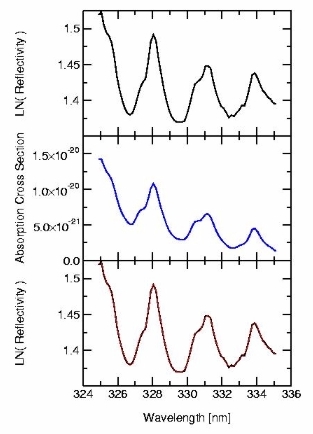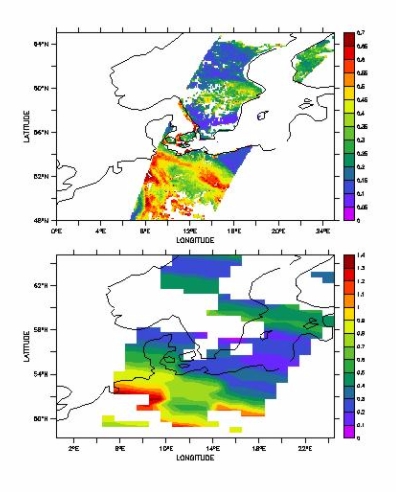|
OMI data products Absorption cross sections of gases often show distinct spectral features. Differential Optical Absorption Spectroscopy (DOAS) uses these spectral features to derive the gas column density. The DOAS method is illustrated in Figure C. In the OMI spectral range, ozone, NO2, BrO, SO2, OClO and HCHO, can be detected using the DOAS technique. In addition to the ozone total column density, also an ozone profile with a vertical resolution of approximately 5 km will be determined from the OMI data. The height information is derived from the rapid increase of the ozone absorption cross section towards the shorter wavelengths in the UV. Figure C. The upper panel shows a simulated reflectivity spectrum. The middle panel shows the ozone absorption cross section (in cm?/molec.) on OMI spectral resolution. In the DOAS method the logarithm of the reflectivity (upper panel) is fitted by a linear combination of the absorption cross section (middle panel) and a polynomial. The fitted spectrum is shown in red in the lower panel, along with the simulated spectrum (in black). |

|
|
Besides the concentration of gases, OMI will also derive information
on clouds and aerosols. The OMI cloud information includes both
the cloud coverage and the cloud top pressure. The cloud parameters
can be used for climate studies, and are important for the retrieval
of other OMI products. Figure D. Comparison between aerosol optical depth at 555 nm derived from ATSR-2 data, and aerosol optical depth at 400 nm derived from GOME data. OMI will use a retrieval technique based on GOME experience (lower panel), but on a resolution comparable to the upper panel, and with daily global coverage. |

|